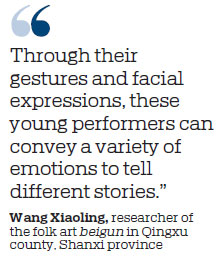Beigun is a unique performance incorporating theater, dance and acrobatics
Lion dances and martial arts displays may be iconic in Chinese New Year celebrations, but Qingxu county in Shanxi province is charming an increasing number of tourists with its unique folk performance during Spring Festival.
Beigun - the art of balancing a child on a rod attached to one's back - features young children standing on small metal plates about 2 meters off the ground that are attached to rods connected to harnesses worn by adults standing below.
The traditional performance dates back to the Ming Dynasty (1368-1644) when toddlers sat on the shoulders of adults to watch the festivities during the Lantern Festival, which falls on the 15th day of the first lunar month, marking the end of Spring Festival.
That inspired villagers to dress young children in elaborate costumes and then be carried on the shoulders of their parents to perform in the streets.
Over the centuries, the once crude art form has developed into a highly sought-after dance show that adds to the New Year excitement in the village.
During the show, a man wears a special costume attached to a harness. A metal rod, fused to the harness, leads to a metal plate, to which a child's legs are secured.

They are both dressed in colorful clothing and headpieces, and when the adult moves around, the child being carried swings his or her arms from side to side, causing the sleeves of their robes to sway in the breeze.
"In the past few centuries in Qingxu, the New Year's celebration has always ended with an authentic beigun performance. Otherwise, it feels incomplete," said Wang Xiaoling, 68, a local researcher of the folk art.
Wang has been learning about beigun for 50 years - from the techniques used to tie the rods and plates, to how to incorporate elements of traditional theater into performances.
"The dance might be plain and repetitive to an onlooker unfamiliar with our culture, but it embodies a whole set of profound and intricate knowledge," he said.
Wang said most beigun themes stem from traditional Chinese myths, legends and theater arts.
"The robes, headgear and makeup of children are meticulously selected to fit the context of the performance, ranging from a nostalgic episode in A Dream of Red Mansions to a joyful tale inspired by The Journey to the West," he said.
"Through their gestures and facial expressions, these young performers can convey a variety of emotions to tell different stories."
In 2017, beigun was listed as a national intangible cultural heritage.
"Thanks to hundreds of years of effort by local folk artists, beigun has now established itself as a unique type of performance that incorporates the narrative of theater, the agility of dance, the breathtaking coordination of acrobatics, and the multicolored nature of painting," Wang said.
Zhang Shuping, deputy director of the county's culture department, said beigun is no longer an annual performance exclusive to Chinese New Year.
"Nowadays, we look forward to enjoying beigun performances during any festival or national holiday," she said.
"With the implementation of the rural revitalization strategy and the boom in rural tourism in recent years, more and more city dwellers have visited Qingxu, and beigun is now able to reach a wider audience."
Contact the writers at wangxiaoyu@chinadaily.com.cn
|
Folk artists from Qingxu county in Shanxi province stage a beigun performance at a temple fair in Xi'an, Shaanxi province, on Monday. Peng Hua / For China Daily |
(China Daily 02/28/2019 page7)